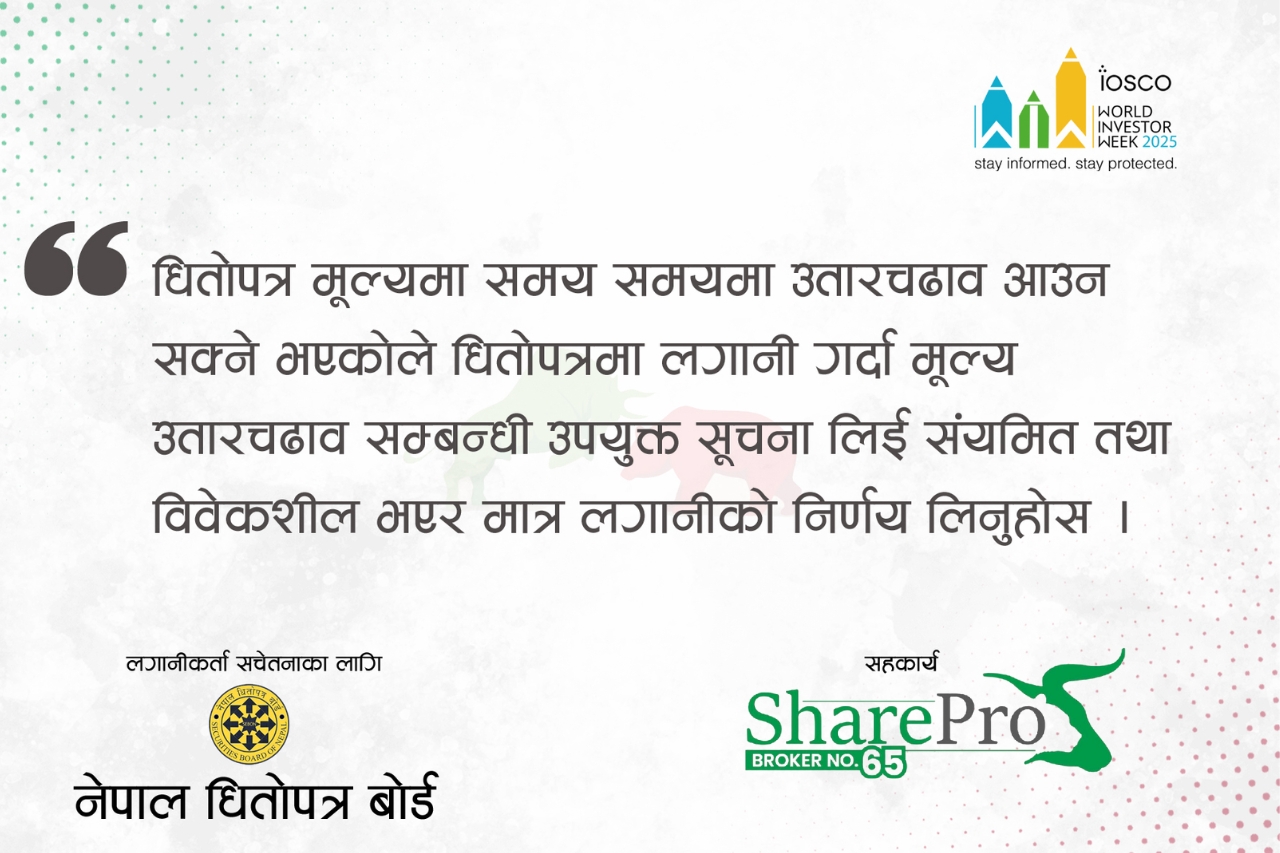Will your investment decision change after studying the comparative analysis of commercial banks' performance? Two State banks lead in three major indicators each
Tue, Feb 12, 2019 4:54 PM on Exclusive, Financial Analysis, Stock Market, Latest,
The end of every quarter in a fiscal year is a perfect analogue to this particular song by Kenny Rogers. The song “The Gambler” rightly puts in this part of the lyrics what an investor goes through every quarter end. It rightly says:
“You’ve got to know when to hold them;
Know when to fold them,
Know when to walk away;
Know when to run”
The second quarter of fiscal year 2075/76 has come to an end. “A” graded commercial banks of the country have published their reports. As an investor, let us compare each of these commercial banks. Let us now decide if we should hold these stocks, throw them away or completely walk away from stock market.
By the end of second quarter, commercial banks have already distributed their dividend to stockholders. The prices of these stocks usually decrease in value post the supply of bonus shares. After evaluating the performance of stocks in second quarter, investors can undertake their investment decision.
The following are the key elements necessary in analyzing the second quarter performance of commercial banks:
- Net profit:
As per the net profit of second quarter of 2075/76, Rastriya Banijya Bank (RBB) is in the lead with a profit of Rs 2.41 arba. Similarly, NABIL Bank Limited (NABIL has the second highest net profit of Rs 2.17 arba in the same quarter. In the third position, Nepal Investment Bank Limited (NIB) has the net profit of Rs 1.97 arba. The bank with the least net profit is Civil Bank Limited (CBL) whose net profit amounts to Rs 35.97 crore.

The industry average net profit of the 28 commercial banks is Rs 1.10 arba. 11 commercial banks have net profit above the industry average. Remaining all banks has net profit below the industry average.
In terms of growth, NIC Asia Bank Limited had the highest growth of net profit compared with last years’ net profit. The bank’s net profit grew by 164% this quarter as compared to the same quarter of last year.

In the NFRS format of financial statements, investors will find several types of income and profits. For instance, profit for the period, comprehensive income, distributable profit, profit after regulatory adjustments, etc. However, the actual profit can be determined through specimen “profit/loss for the period” of financial statement.
- Paid up capital:
Paid up capital in NFRS refers to the amount of money that commercial banks have received from their shareholders through the exchange of shares in the primary market. The central bank of the country has directed these “A” categorized banks to meet the paid up capital requirement of at least 8 arba. Nepal Credit and Commercial Bank (NCCB), Bank of Kathmandu Limited (BOKL) and Kumari Bank Limited (KBL) are still to meet the paid up capital requirement.
The bank with highest paid up capital are Nepal Investment Bank (NIB) with Rs 12.59 arba capital, Mega Bank Limited (MEGA) with Rs 10.39 arba and Global IME Bank Limited (GBIME) with Rs 10.31 arba paid up capital.

- Reserve and surplus:
With an industry average of Rs 6.28 arba, eight banks stand above the average range of Rs 6.28 arba in their reserve fund.
In terms of reserves and surplus, Nepal Bank Limited (NBL) has maintained its lead with a reserve and surplus of Rs 19.65 arba. Nabil Bank Limited (NABIL) has maintained second position with Rs 14.52 arba reserve and surplus fund. Agriculture Development Bank Limited (ADBL) is in the third position with reserve and surplus of Rs 14.22 arba. The bank with least reserve and surplus is Century Commercial Bank Limited (CCBL) with a reserve of Rs 1.64 arba.

The bank with highest growth in Reserve and Surplus as compared to last year is Nepal Bank Limited with a growth of 289%.

- Deposit collection:
In an average, commercial banks have collected Rs 94.84 arba as deposit. Only 12 banks are above the average deposit collection.
In the banking sector, the deposit collection will play a major role in the upcoming days. All the banks have the same range of paid up capital which is equal or above Rs 8 arba. So, the commercial banks are going through a severe competition with each other in order to attract the deposit clients. As of the second quarter of FY 2075/76, Rastriya Banijya Bank (RBB) stands on top with total deposits worth Rs 1.81 kharba. NIC Asia is aggressively involved in collecting deposits from existing and prospective clients with deposits of Rs 1.75 kharba. Similarly, the bank is followed by NABIL Bank Limited (NABIL) with the collected deposit of Rs 1.49 kharba respectively. Civil Bank Limited (CBL) has the lowest deposit collection of Rs. 43.08 arba only.

The total deposit collected by the industry is Rs 26.55 kharba.
Mega Bank Limited had the highest growth in deposits compared with deposits of last year. The bank’s deposit portfolio grew by 55%.

- Loans and advances:
In today’s context, the concern of commercial banks simply does not rest upon which bank has more loans. Today’s concern is upon the loan portfolio that the banks have been able to create. As shown in the figure, the top position in loans and advances is occupied by NICA Bank Limited (NICA) with credit disbursement worth Rs 1.49 kharba. Rastriya Banijya Bank (RBB) has a loan and advances portfolio of Rs. 1.34 kharba. Nabil Bank Limited (NABIL) has the loan portfolio of Rs 1.30 kharba. Similarly on the other end of the rope, stands Civil Bank Limited (CBL) with the lowest loan and advances portfolio of Rs. 43.55 arba.

The industry average loan disbursed is Rs 84.46 arba. 13 commercial banks have the loan portfolio above Rs 84.46 arba. The total loan disbursed is Rs 23.64 kharba.
The bank with highest growth in loan portfolio compared with the second quarter of last year is Mega Bank Limited. The growth rate of the bank is 62% in loan portfolio.

- Free profit/loss after regulatory adjustments:
This free profit/loss is related with the statement of reconciliation published in financial reports. Commercial banks are required to reconcile profit between NFRS financials and NRB Directives, 2074 based financials. The bank with highest free profit after regulatory adjustment is Rastriya Banijya Bank (RBB) is Rs 2.17 arba. In the second position, NABIL Bank Limited (NABIL) has the second highest free profit after regulatory adjustment that accounts to Rs 2.04 arba. It is further followed by Nepal Investment Bank Limited (NIB) with an amount of Rs 1.72 arba.

The industry average free profit after regulatory adjustment accounts to Rs 96.68 crore.
Major indicators:
- Earnings per share (Annualized):
With the increment in the paid-up capital requirement, the EPS of these banks were expected to fall. However, some commercial banks have managed to maintain their EPS better than others. Nabil Bank Limited (NABIL) becomes the bank to serve investors with highest annualized EPS of Rs 54.28 per share. Rastra Banijya Bank (RBB) has the second highest EPS of Rs 53.33 per share. Everest bank limited (EBL) in the third position with annualized EPS of Rs 35.36 per share. Civil Bank Limited (CBL) stays at the bottom with an earning of Rs. 9.01 per share.

The average EPS of 28 commercial banks stands at Rs 25.61. Ten commercial banks still provide EPS higher than that of the industry average.
NIC Asia Bank limited is the bank with highest growth of 141% in EPS of this year compared with last quarter in the same period.

(In the old format, investors calculated EPS through “net profit divided by no. of outstanding shares”. However, the EPS calculation is not possible through the same approach in context of NFRS format. Under NFRS, Weighted number of outstanding shares is taken to calculate EPS. Hence, investors should rely on the published EPS.)
- Net worth per share:
The highest net worth per share among these commercial banks is Rs 300.28 which belongs to Nepal Bank Limited (NBL). Nabil Bank Limited (NABIL) is in the second position with Rs 280.57. Rastriya Banijya Bank (RBB) has the third highest net worth per share as of Q2 of FY 2075/76 i.e. Rs 238.20. Century Commercial Bank Limited (CCBL) has the least net worth of Rs 120.34 per share.

The industry average net worth stands around Rs 170.35 per share. 10 companies have net worth more than the industry average.
Nepal Bank Limited is the bank with highest growth in terms of net worth per share. The growth is 84%.

- P/E ratio:
Nepal Bank Limited (NBL) has the least PE ratio of 8.41 times. It is followed by Prabhu Bank Limited (PRVU) with PE ratio of 9.32 times and finally Standard Chartered Bank (SCB) has highest PE ratio of 19.27 times.

17 commercial banks have a P/E ratio lower than the industry average of 12.25 times. This figure suggests that commercial banks are cheaper than expected.
In a nutshell:
Finally the table below provides a full picture with major indicators of the 28 commercial banks as of the second quarter of FY 2075/76:

Dear investors, please feel free to share your investment decision after the performance evaluation of key indicators of these commercial banks.



 -Dheerusha Tiwari
-Dheerusha Tiwari